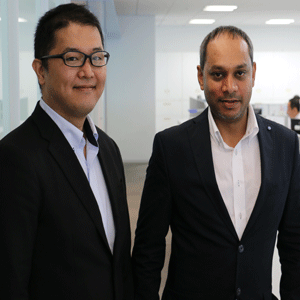THANK YOU FOR SUBSCRIBING

The Cloud Computing Adoption
Yoichi Inoue, Deputy Head of Digital Booster and Ramdoyal Veda, Cloud Solution Architect, AXA Japan


Yoichi Inoue, Deputy Head of Digital Booster and Ramdoyal Veda, Cloud Solution Architect, AXA Japan
Due to fierce competition on the market, there has been a great demand from business owners to launch new services and applications quicker.Cloud Computing provides the speed and agility for delivery of computing resources. Customer feedback is very important during the prototype phase. Combining cloud computing capabilities with agility thus allow enterprise to get a prototype ready based on the requirements. This prototype can be simulated by using different latest technologies. Customers can have a look at the new services or applications at an early stage. The Minimum Viable Product (MVP) does conform to the iterative process of innovation where the ideas can be tested in the pilot phase.
While aligning business and IT strategies, cloud adoption at the enterprise level is inevitable. Insurers are coming up with new ideas such as rewarding consumers that are following a healthy life-style. Many health kit devices are being used by different group of people.
"Cloud computing provides the speed and business agility for delivery of computing resources"
Those data are expected to be compiled and transform to integrate with the company systems. Such new business models are achieved quicker today with the opportunities existing in the cloud. New customers are also targeted. Running of those new campaigns at times result into spike in traffic. Thanks to cloud computing, scalability is well managed to cope with such demands.
See Also: Top Cloud Solution Companies
Today the challenges facing Enterprises are complex and there is more reliance on IT to support the business activities. Using of proper technology has become a strategic asset. The ultimate goal is to embark the customers on a full digital platform. With the trend of technology-driven strategy, there is an absolute need to attract and retain talents. The strategic vision of how technology will transform the business is derived from top management and cascaded to the digital team heads. Digital teams are the gate keepers of ensuring that the digital transformation is with in track. The teams usually comprise of very enthusiastic and eager talented engineers with multiple skills set, working very closely with global innovation labs established within the organizations.
One of the obvious concerns of cloud adoption is security and compliance. While engaging the Security team at earlier stage, Enterprise is able to extend their strong governance of security policies on to the cloud. Furthermore cloud is automation friendly that allow security testing to integrate with the continuous delivery pipeline. Security built on cloud infrastructure also provides near real time monitoring for sensitive data and encryption features that do help in achieving even higher levels of data protection and compliance.
Within the digital transformation plan, the 360-degree customer view starts to formulate. And Cloud computing allow defining and implementing touch points with customers in areas that were not visible before. Moving gradually from the legacy systems is a good move for embracing innovation. Cloud computing is here to stay. An Enterprise running their business models on the cloud in a private, public or hybrid approach is no doubt taking a leap ahead in the future digital world.
Weekly Brief
I agree We use cookies on this website to enhance your user experience. By clicking any link on this page you are giving your consent for us to set cookies. More info
Read Also













